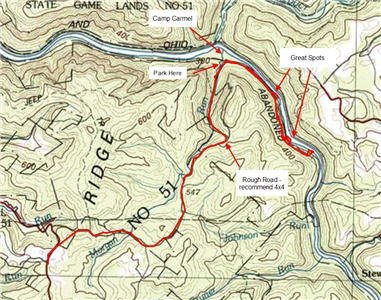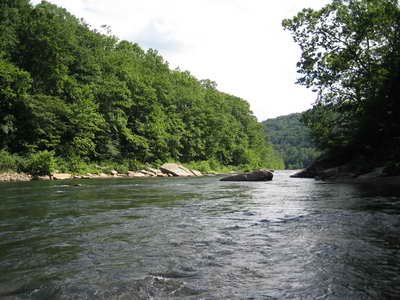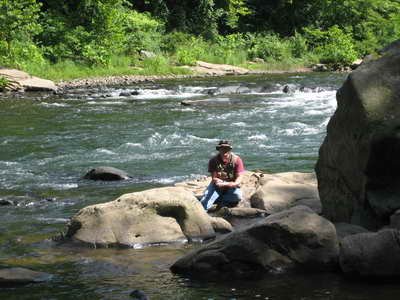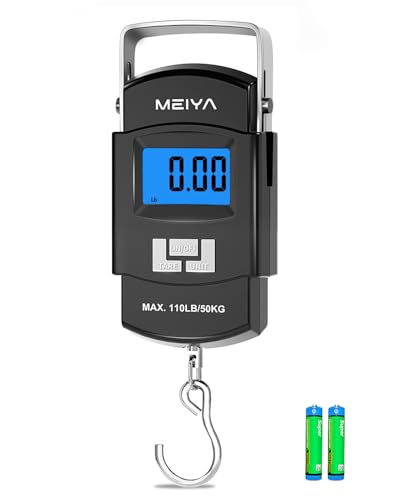I had been watching the long term weather on Accuweather.com for 15 days – checking it two or three times a day in anticipation of this weekend. John and I were going to camp up near the Youghiogheny [yaw-ki-GAY-nee] River Gorge (aka the “yawk”) near the Ohiopyle State Park and work the river hard for a few days.
John grew up in the area and he agreed to show me the ropes on the Yawk – assisted by his good buddy, Howard. Between the three of us, we had a spectacular time.
John and I headed west from Fairfax early Friday as we had lost our tolerance for work with fishing in front of us. It was a quick, clean drive to get to the Uniontown area in PA. We only had rough directions to the Camp Carmel trailhead and John’s dated recollections – which were confused a bit by a posting he saw that stated that there would be a locked gate that would prevent easy access to the bike trail that parallels the river. Fortunately, the posting turned out to be inaccurate, and we were able to make our way to the river following the rough path shown. We parked where the road meets the bike trail, geared up and hit the river at around 1600 on Friday.
And what a river this is! It’s wide and deceptive – with deep, deep holes protected by a rapid flow that makes wading to get to the good spots a bit of a sport. Howard joked that he saw me work for 30 minutes up and over and back down to get to a spot 12 feet away from the bank – but that is the approach you need to take to make sure you can work the good areas. Access is easy. The Youghiogheny River Trail runs next to the river. It’s an old railbed that has been converted to an exceptional bike trail – it’s flat and level – an easy ride to judge by the wide variety of body types and ages perched upon all sorts of bikes we saw traversing the length of the river. But… we were here to fish. In fact, I just don’t get it – to ride a bike just to ride is like hiking just to hike – there needs to be a purpose, a goal beyond physical exersion – like fishing! Riding or hiking to get to a fishing spot is understandable – the other is just plain mysterious.
According to the PA DNR website: “The Youghiogheny River Trail has 27 miles of trail in the park and is part of the Great Allegheny Passage that connects Pittsburgh, Pennsylvania and Cumberland, Maryland. The flat, crushed limestone trail was once the rail bed for the Western Maryland Railroad. This trail is suitable for all ages and accessible to people with disabilities. Rental bicycles are available. The trail is excellent for hiking, jogging and cross-country skiing and can be used to combine a bike ride or hike with some excellent wilderness trout fishing or hunting. All motorized vehicles and equestrians are prohibited.”
Notice that they do not mention fishing! We did not see any other fish hikers in our two days. We saw a few boys perched at Camp Carmel still fishing, but that was it – this river is unpressured!
Anyway, we fished Friday until around 1900 or so as John educated me on how to bump worms along the bottom of the river. He caught a few really nice rainbows and smallies which he released unharmed. I know there is a constant controversy about bait fishing vs other methods because of the potential damage to the fish. However, I think that depends on the type of hook being used. We were using a single, medium sized hook and every fish I saw caught had the hook in the mouth – not in the gullet – which allowed their easy release. If you were to use the small size trebles, I bet the result would be spectacularily different as that would be pulled down the throat where it would be very hard to dislodge without harming the fish. So, don’t go crazy on the bait thing – all our fish were OK.
We camped at Brennan’s Campground that evening. This is a well developed public campsite fairly near to Camp Carmel. It was packed with happy kids and people of all ages as it featured a pool, showers, mini-golf, a rec room, and even had a live band on Saturday night. The downside to the site was that people tend to stay up late and talk – really late – and the sound carries in the still of the night. If you stay in a place like this, you need to bring some heavy duty, 32 decibel foam earplugs. Fortunately, I had a pair in my shaving kit and was ok for both nights..
Howard joined us on Friday night and we agreed to get moving early the next morning – waking up at 0530 with the intent to get to the river as quickly as possible. The next day came too quickly and I hauled my old bones out of bed to encounter the stunning and horrific fact that we had not brought anything to boil water in for coffee.

We ate a quick breakfast of eggs and hebrew nationals and rolled out to find a cup at the local Sunoco – a 10 mile detour from the river. Finally, we made it back and we started to work the area around Camp Carmel. The river was wide and slow here and we waded out to jig the bait rigs downstream. The technique is to put a worm or maggot on the hook with a few split shots and then slowly let the line out. Once the line is out, hestitate and begin a slow start and stop retrieve. Howard and John were having good luck with this. I could not bring myself to use the bait until I proved to myself that my rapallas and Panther Martins were not going to be effective.
I discovered that the river was running too fast for either of these lures. As soon as you would throw one out, it would be swept downstream – forcing an unnatural upstream retrieve at odd depths. It only took a few hard headed hours to realize that this was not the pattern, and I switched to the Red Worms as well as the trout style GULP Worm.
We were catching smallies all day – to include a nice 20 incher that John caught and released (nothing was kept or hurt). Made me conclude that this is a river where bass style plastic worms would be very effective. They are heavy enough when Texas or Caroline rigged to plunge to the bottom and find the fish. I also noted numerous crawfish exoskeletons along the shore – but I was without a single 2 inch plastic crawfish to take advantage of that – bet those rigs would have increased the catch.
We worked our way up the river slowly and quickly concluded that the deep wide stretches of the river were not as productive as the fast water around the riffles and rapids. With that conclusion, we limited our fishing to those spots. We would work a spot for an hour or so and then climb up the bank, walk down the bike trail scanning the river for the next likely spot – that’s how we put about 9 miles of walking under our belt on Saturday.
The two good spots marked on the map were the most productive. John must have caught 10 – 15 trout/bass at the southernmost of the two. I caught a nice 17 inch ‘bow there as well – a good reward for the lengthly and challenging wade up and across the river to get to just the right spot. That brings up a key safety point – I recommend you carry a good Wading Staff if you are going to work this river – it gives you a third point of balance and will save you a few spills.
We rolled into camp that evening, had a great dinner of steak and potatoes, drank some beer and listened to the band. Sunday morning, we headed home – tired but happy.
A point to consider – you may want to take a bike with you. It would be a fast way to get from spot to spot without wasting alot of time hiking.
Getting There: Best bet is to follow the directions posted at Camp Carmel:
“Take 119 North from Uniontown or South from Connellsville to the Fayette County Fairgrounds. Turn right if coming from Uniontown onto Pechin Road. (If coming from Connellsville turn left). Go about one mile, as you pass a cemetery on the left you will turn left. Go straight, through two stop signs. Stay on this road, which bears to the right at Stefanoe’s Printing, until you come to Kingan Hill Road. Turn left on to Kingan Hill Road which eventually becomes Liston Road. Go about 2.5 miles and bear right at the bottom of the first steep hill. Go about one mile to the second steep hill. Follow it to the bottom and turn left onto the bike trail.”

The Yawk is wide, broad and deep.

We found the areas with faster water to be the most productive

John with the first fish of the day – a nice ‘bow

Another beauty that John caught on Friday… and the last picture taken on this trip as I slipped and took a bath in the river… Camera all messed up – instantly made the decision to buy a digital camera – the Olympus Stylus 720SW – that is water resistant! It is waterproof to 10 feet and can handle a 5 foot drop. That’s the ticket…
Unless stated otherwise, this article was authored by Steve Moore


